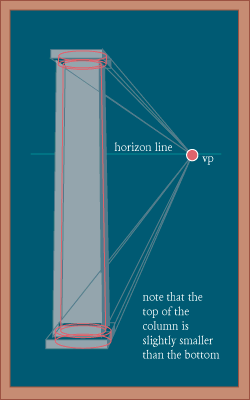![]()
16 column
 |
Lynette Matson
asked about creating a trompe l'oeil image of columns for a room that she
is painting. One thing to always remember when you are creating trompe
l'oeil ("fool the eye" in French) images is to take into
consideration the point of view of the audience. The best way to make a
believable illusion is to use the viewer's horizon line as the horizon
line for the image that you are painting. If your viewer will be walking
into a room, you want the horizon line to be at their eye level.
After establishing a horizon line, create a block version of the column, even if you are creating a round one. This will establish where the edges of the circular sections. For more information on creating block objects in one-point perspective follow this link. After you have created a block form similar to the one in the diagram at left, create circles in perspective (they will look like ovals) using the edges of the blocks as a guide. For more information on creating circles in one-point perspective follow this link.
|
| Once
you have arrived at his point, you will want to use shading to make your
illusion complete. Try creating a gradation that begins with light gray at
left, then becomes white, then returns to a very dark gray. For
more information on creating value gradations follow this link and read
the two pages dedicated to shading that follow.
By adding color to this formula, you should be able to create an illusion. Hint: When painting trompe l'oeil illusions, one should use matt finishes. The reflections caused by shiny gloss surfaces detracts from the impact of the illusion. Hint:
Creating patterns often add to the illusion by making an
area seem to have a texture.
|
|
| Back to 15 |